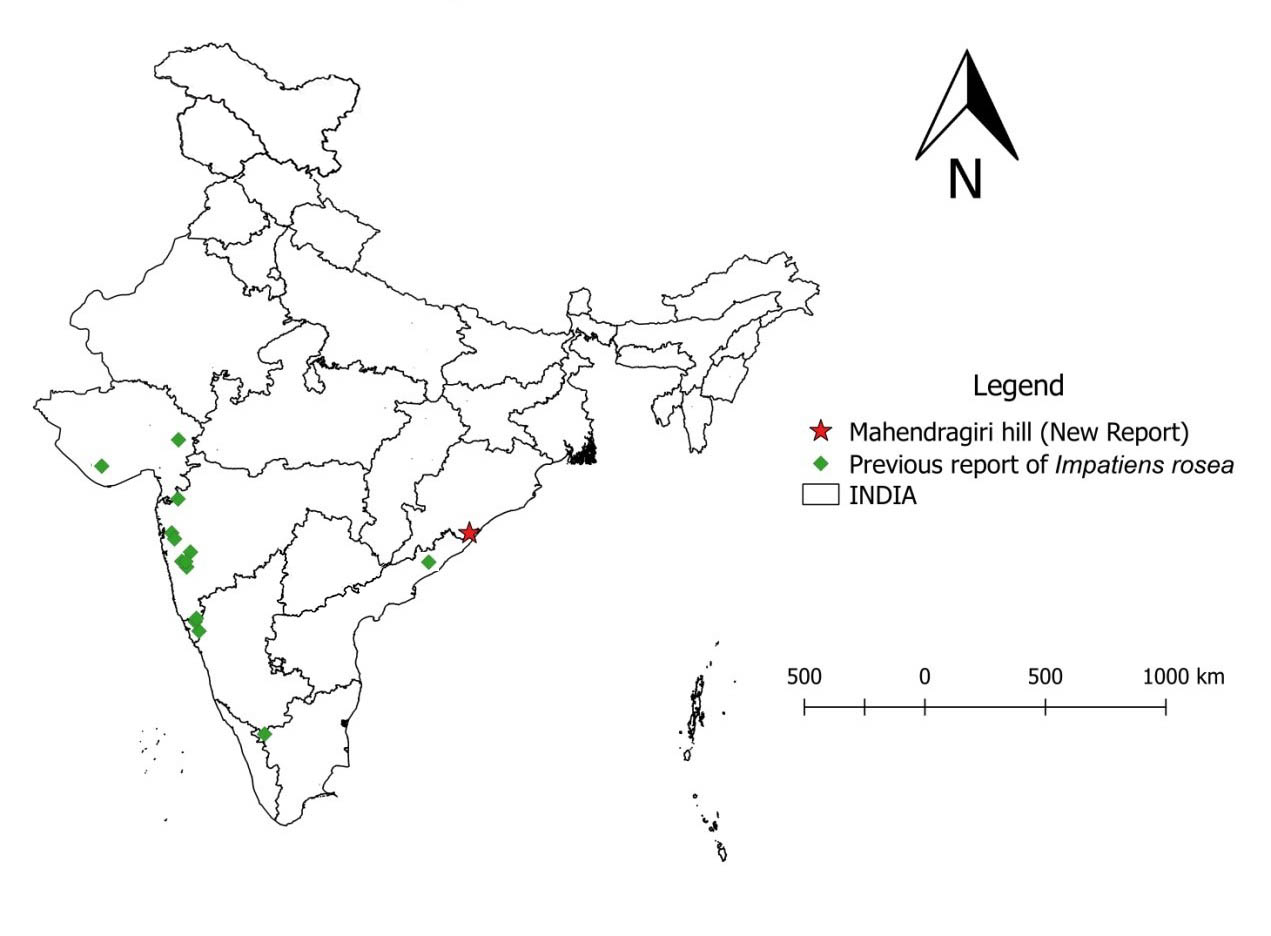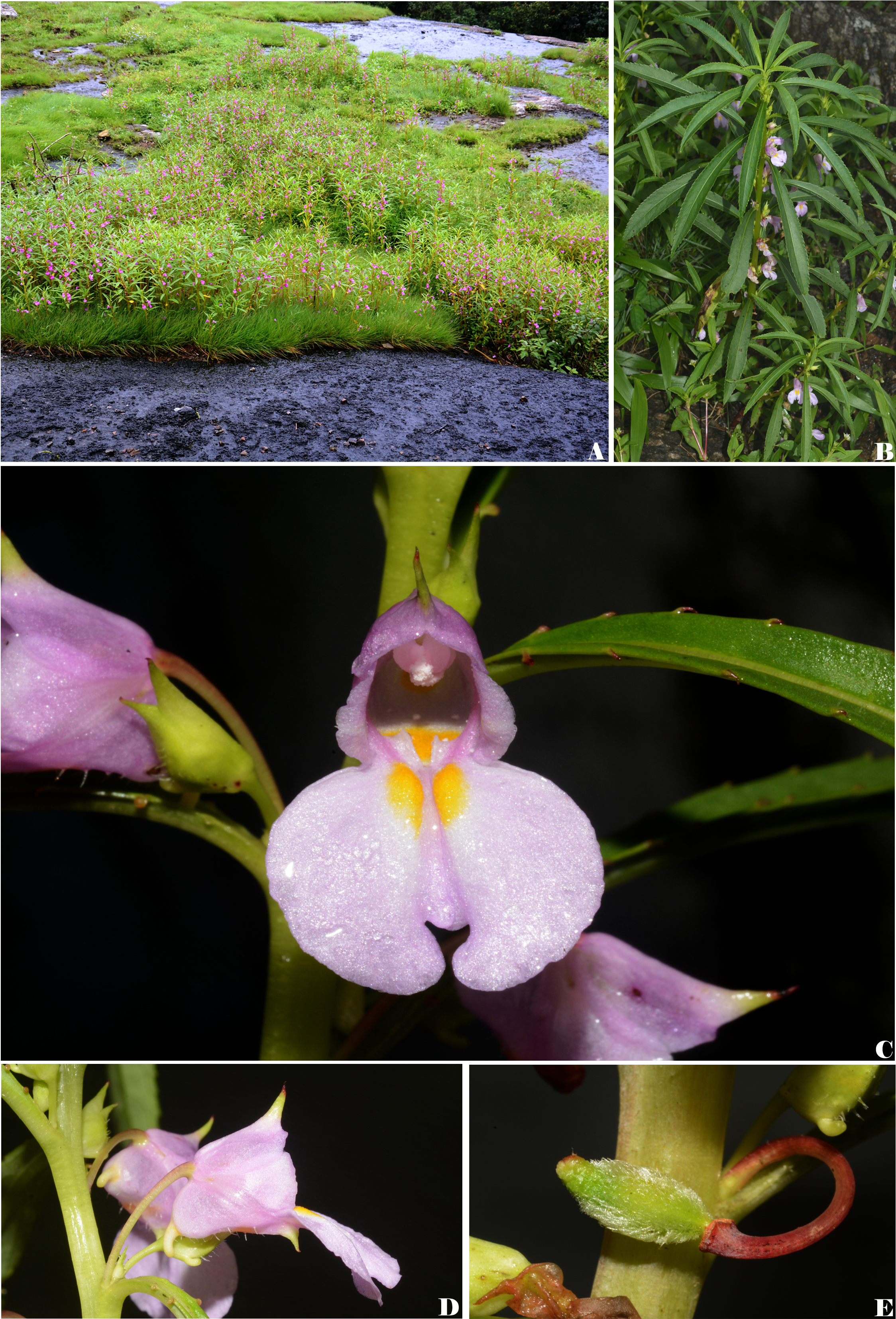INTRODUCTION
The genus Impatiens L. (Balsaminaceae) is distributed in the tropical and subtropical regions of the Old World and northern temperate regions, comprising about 1,000 species (APG IV, 2016; Mabberley, 2017). Main centers of diversity of the genus are in tropical Africa, Madagascar, Southern India, Sri Lanka, the Eastern Himalaya and Southeast Asia (Gogoi et al., 2018). In India, the genus Impatiens is represented by more than 210 species with high concentration of species in Eastern Himalaya and Western Ghats (Gogoi et al., 2018). During the recent botanical explorations in Mahendragiri hills of Eastern Ghats of Odisha state, the authors collected some curious specimens of Impatiens from the high-altitude areas of Gajapati district. After critical study, the collected specimens were identified as Impatiens rosea Lindl. The perusal of relevant literature (Gamble, 1915; Pullaiah & Muralidhara, 2002; Saxena & Brahmam, 1994) revealed that this species has not been reported from Odisha to date. A detailed botanical description, phenology, distribution pattern and photographs are provided here for easy identification. The collected materials have been deposited in the herbarium of BSI, Deccan Regional Centre, Hyderabad (BSID).
Description
Impatiens rosea Lindl. in Edwards’s Bot. Reg. 27(Misc.): 6, t. 27. 1841. I. trichocarpa Hook.f., Hooker’s Icon. Pl. 30: t. 2914. 1910; Gamble, Fl. Pres. Madras 1: 142. 1915; Vivekananthan et al. in Hajra et al., Fl. India 4: 218. 1997. I. balsamina L. var. rosea (Lindl.) Hook. f., Fl. Brit. India 1: 454. 1874. (Fig. 1).
Herbs, about 40 cm high. Roots many, filiform. Stem terete, smooth, pale green. Leaves alternate, linear-lanceolate or linear-oblanceolate, 4-8 × 0.5-1 cm, acuminate at apex, attenuate at base, serrate at margins; petioles 0.5-1 cm long, with 2-5 pairs of glands. Flowers 1-3 per axil, 1.5-2 cm across, pink with yellow patches on throat. Bracts small, triangular, 1-1.5 mm long, hairy; pedicels 8–10 mm long, puberulous or glabrous, pale green or pink. Lateral sepals ovate-lanceolate, 2-2.5 × 1 mm, acute at apex, hairy at margins. Standard petal concave, horned, orbicular, 0.8-1 cm long, sparsely hairy on dorsal surface; horn 2.5-3 mm long, green; wing petals 1.6-1.8 × 0.9-1 cm, 2-lobed; auricle curved, rounded; basal lobe obovate, 6-8 × 3.8-4 mm, obtuse at apex; dorsal lobe irregularly obovate, 9-10 × 6-8 mm; lip boat-shaped, horned, 1-1.2 × 4-6 mm, c. 4 mm deep, acuminate at apex, hairy; horn 1.8-2 mm long, green; spur slightly hooked, cylindric, 6-8 mm long, rounded, pale green. Column c. 6 × 3 mm, white; filaments 5.5-6 mm long. Anthers 1 mm long, pinkish-white. Pistil 4.6-5 mm long, curved; ovary elliptic-lanceolate. Capsules ellipsoid, 1-1.2 cm long, tomentose; pedicels 1-1.5 cm long; seeds globose.
Flowering & Fruiting: July-December.
Habitat: It grows on large rock surfaces at elevation between 1390-1400 m above msl. The present population was found to have about 300 mature individuals.
Distribution: Northern Himalaya, Andhra Pradesh, Goa, Gujarat, Karnataka, Maharashtra, Odisha and Tamil Nadu. (Map 1.)
Specimens examined: India, Odisha, Gajapati district, Mahendragiri hills, N 18°58’05.3” E 84°22’08.6”, 1395m, 17-09-2014, K. Prasad & Alok Chorghe 4216 (BSID).

Map 1. Distribution map of Impatiens rosea from India.

Figure 1. Impatiens rosea Lindl.- A. Habitat, B. Habit, C. Close up of flower, D. Side view of flowers with short spur, E. Young capsule
Acknowledgements
The first author gratefully acknowledges financial assistance received from Department of Science and Technology (SERB-DST), New Delhi and the Director, Botanical Survey of India for facilities and encouragement. The authors are also thankful to Odisha Forest officials for necessary permission and logistic support during field studies.

